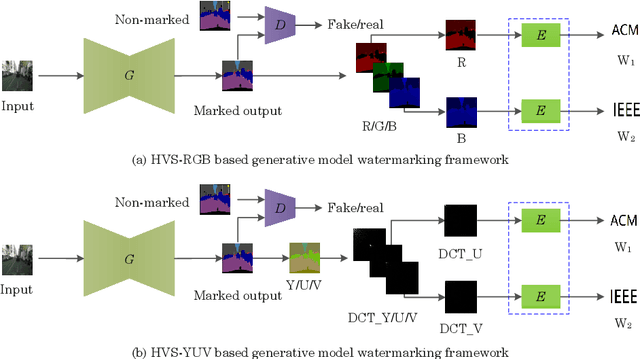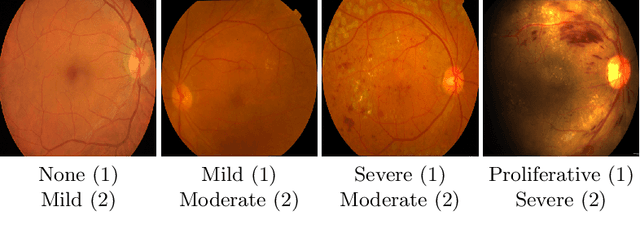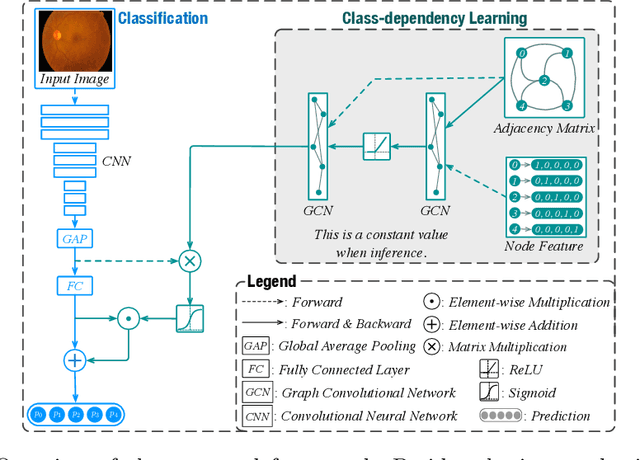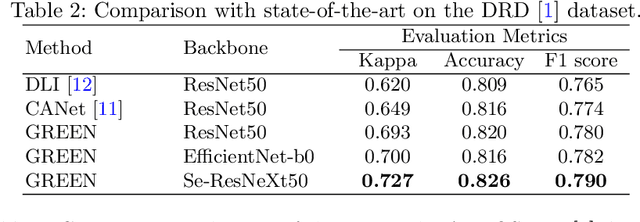Shaoteng Liu
Generative Video Propagation
Dec 27, 2024Abstract:Large-scale video generation models have the inherent ability to realistically model natural scenes. In this paper, we demonstrate that through a careful design of a generative video propagation framework, various video tasks can be addressed in a unified way by leveraging the generative power of such models. Specifically, our framework, GenProp, encodes the original video with a selective content encoder and propagates the changes made to the first frame using an image-to-video generation model. We propose a data generation scheme to cover multiple video tasks based on instance-level video segmentation datasets. Our model is trained by incorporating a mask prediction decoder head and optimizing a region-aware loss to aid the encoder to preserve the original content while the generation model propagates the modified region. This novel design opens up new possibilities: In editing scenarios, GenProp allows substantial changes to an object's shape; for insertion, the inserted objects can exhibit independent motion; for removal, GenProp effectively removes effects like shadows and reflections from the whole video; for tracking, GenProp is capable of tracking objects and their associated effects together. Experiment results demonstrate the leading performance of our model in various video tasks, and we further provide in-depth analyses of the proposed framework.
Mini-Gemini: Mining the Potential of Multi-modality Vision Language Models
Mar 27, 2024



Abstract:In this work, we introduce Mini-Gemini, a simple and effective framework enhancing multi-modality Vision Language Models (VLMs). Despite the advancements in VLMs facilitating basic visual dialog and reasoning, a performance gap persists compared to advanced models like GPT-4 and Gemini. We try to narrow the gap by mining the potential of VLMs for better performance and any-to-any workflow from three aspects, i.e., high-resolution visual tokens, high-quality data, and VLM-guided generation. To enhance visual tokens, we propose to utilize an additional visual encoder for high-resolution refinement without increasing the visual token count. We further construct a high-quality dataset that promotes precise image comprehension and reasoning-based generation, expanding the operational scope of current VLMs. In general, Mini-Gemini further mines the potential of VLMs and empowers current frameworks with image understanding, reasoning, and generation simultaneously. Mini-Gemini supports a series of dense and MoE Large Language Models (LLMs) from 2B to 34B. It is demonstrated to achieve leading performance in several zero-shot benchmarks and even surpasses the developed private models. Code and models are available at https://github.com/dvlab-research/MiniGemini.
RL-GPT: Integrating Reinforcement Learning and Code-as-policy
Feb 29, 2024



Abstract:Large Language Models (LLMs) have demonstrated proficiency in utilizing various tools by coding, yet they face limitations in handling intricate logic and precise control. In embodied tasks, high-level planning is amenable to direct coding, while low-level actions often necessitate task-specific refinement, such as Reinforcement Learning (RL). To seamlessly integrate both modalities, we introduce a two-level hierarchical framework, RL-GPT, comprising a slow agent and a fast agent. The slow agent analyzes actions suitable for coding, while the fast agent executes coding tasks. This decomposition effectively focuses each agent on specific tasks, proving highly efficient within our pipeline. Our approach outperforms traditional RL methods and existing GPT agents, demonstrating superior efficiency. In the Minecraft game, it rapidly obtains diamonds within a single day on an RTX3090. Additionally, it achieves SOTA performance across all designated MineDojo tasks.
Direct Inversion: Boosting Diffusion-based Editing with 3 Lines of Code
Oct 19, 2023Abstract:Text-guided diffusion models have revolutionized image generation and editing, offering exceptional realism and diversity. Specifically, in the context of diffusion-based editing, where a source image is edited according to a target prompt, the process commences by acquiring a noisy latent vector corresponding to the source image via the diffusion model. This vector is subsequently fed into separate source and target diffusion branches for editing. The accuracy of this inversion process significantly impacts the final editing outcome, influencing both essential content preservation of the source image and edit fidelity according to the target prompt. Prior inversion techniques aimed at finding a unified solution in both the source and target diffusion branches. However, our theoretical and empirical analyses reveal that disentangling these branches leads to a distinct separation of responsibilities for preserving essential content and ensuring edit fidelity. Building on this insight, we introduce "Direct Inversion," a novel technique achieving optimal performance of both branches with just three lines of code. To assess image editing performance, we present PIE-Bench, an editing benchmark with 700 images showcasing diverse scenes and editing types, accompanied by versatile annotations and comprehensive evaluation metrics. Compared to state-of-the-art optimization-based inversion techniques, our solution not only yields superior performance across 8 editing methods but also achieves nearly an order of speed-up.
Self-supervised Learning by View Synthesis
Apr 22, 2023Abstract:We present view-synthesis autoencoders (VSA) in this paper, which is a self-supervised learning framework designed for vision transformers. Different from traditional 2D pretraining methods, VSA can be pre-trained with multi-view data. In each iteration, the input to VSA is one view (or multiple views) of a 3D object and the output is a synthesized image in another target pose. The decoder of VSA has several cross-attention blocks, which use the source view as value, source pose as key, and target pose as query. They achieve cross-attention to synthesize the target view. This simple approach realizes large-angle view synthesis and learns spatial invariant representation, where the latter is decent initialization for transformers on downstream tasks, such as 3D classification on ModelNet40, ShapeNet Core55, and ScanObjectNN. VSA outperforms existing methods significantly for linear probing and is competitive for fine-tuning. The code will be made publicly available.
Video-P2P: Video Editing with Cross-attention Control
Mar 08, 2023Abstract:This paper presents Video-P2P, a novel framework for real-world video editing with cross-attention control. While attention control has proven effective for image editing with pre-trained image generation models, there are currently no large-scale video generation models publicly available. Video-P2P addresses this limitation by adapting an image generation diffusion model to complete various video editing tasks. Specifically, we propose to first tune a Text-to-Set (T2S) model to complete an approximate inversion and then optimize a shared unconditional embedding to achieve accurate video inversion with a small memory cost. For attention control, we introduce a novel decoupled-guidance strategy, which uses different guidance strategies for the source and target prompts. The optimized unconditional embedding for the source prompt improves reconstruction ability, while an initialized unconditional embedding for the target prompt enhances editability. Incorporating the attention maps of these two branches enables detailed editing. These technical designs enable various text-driven editing applications, including word swap, prompt refinement, and attention re-weighting. Video-P2P works well on real-world videos for generating new characters while optimally preserving their original poses and scenes. It significantly outperforms previous approaches.
Generative Model Watermarking Based on Human Visual System
Sep 30, 2022



Abstract:Intellectual property protection of deep neural networks is receiving attention from more and more researchers, and the latest research applies model watermarking to generative models for image processing. However, the existing watermarking methods designed for generative models do not take into account the effects of different channels of sample images on watermarking. As a result, the watermarking performance is still limited. To tackle this problem, in this paper, we first analyze the effects of embedding watermark information on different channels. Then, based on the characteristics of human visual system (HVS), we introduce two HVS-based generative model watermarking methods, which are realized in RGB color space and YUV color space respectively. In RGB color space, the watermark is embedded into the R and B channels based on the fact that HVS is more sensitive to G channel. In YUV color space, the watermark is embedded into the DCT domain of U and V channels based on the fact that HVS is more sensitive to brightness changes. Experimental results demonstrate the effectiveness of the proposed work, which improves the fidelity of the model to be protected and has good universality compared with previous methods.
On-target Adaptation
Sep 02, 2021



Abstract:Domain adaptation seeks to mitigate the shift between training on the \emph{source} domain and testing on the \emph{target} domain. Most adaptation methods rely on the source data by joint optimization over source data and target data. Source-free methods replace the source data with a source model by fine-tuning it on target. Either way, the majority of the parameter updates for the model representation and the classifier are derived from the source, and not the target. However, target accuracy is the goal, and so we argue for optimizing as much as possible on the target data. We show significant improvement by on-target adaptation, which learns the representation purely from target data while taking only the source predictions for supervision. In the long-tailed classification setting, we show further improvement by on-target class distribution learning, which learns the (im)balance of classes from target data.
Multi-modal Cooking Workflow Construction for Food Recipes
Aug 20, 2020



Abstract:Understanding food recipe requires anticipating the implicit causal effects of cooking actions, such that the recipe can be converted into a graph describing the temporal workflow of the recipe. This is a non-trivial task that involves common-sense reasoning. However, existing efforts rely on hand-crafted features to extract the workflow graph from recipes due to the lack of large-scale labeled datasets. Moreover, they fail to utilize the cooking images, which constitute an important part of food recipes. In this paper, we build MM-ReS, the first large-scale dataset for cooking workflow construction, consisting of 9,850 recipes with human-labeled workflow graphs. Cooking steps are multi-modal, featuring both text instructions and cooking images. We then propose a neural encoder-decoder model that utilizes both visual and textual information to construct the cooking workflow, which achieved over 20% performance gain over existing hand-crafted baselines.
GREEN: a Graph REsidual rE-ranking Network for Grading Diabetic Retinopathy
Jul 21, 2020



Abstract:The automatic grading of diabetic retinopathy (DR) facilitates medical diagnosis for both patients and physicians. Existing researches formulate DR grading as an image classification problem. As the stages/categories of DR correlate with each other, the relationship between different classes cannot be explicitly described via a one-hot label because it is empirically estimated by different physicians with different outcomes. This class correlation limits existing networks to achieve effective classification. In this paper, we propose a Graph REsidual rE-ranking Network (GREEN) to introduce a class dependency prior into the original image classification network. The class dependency prior is represented by a graph convolutional network with an adjacency matrix. This prior augments image classification pipeline by re-ranking classification results in a residual aggregation manner. Experiments on the standard benchmarks have shown that GREEN performs favorably against state-of-the-art approaches.
 Add to Chrome
Add to Chrome Add to Firefox
Add to Firefox Add to Edge
Add to Edge